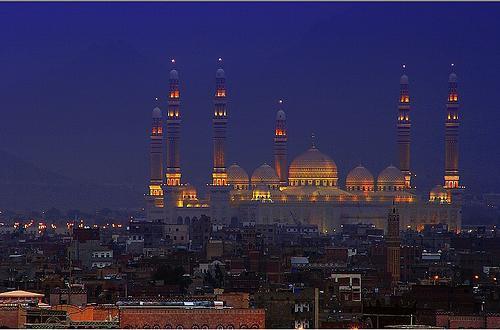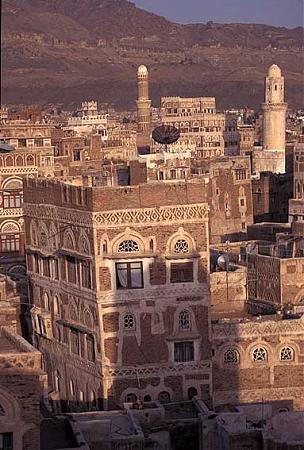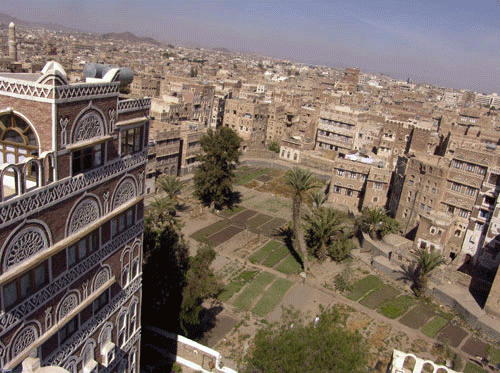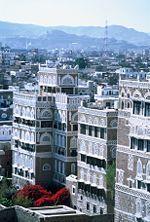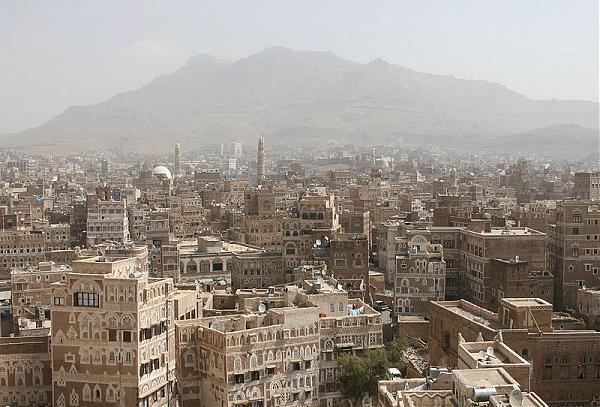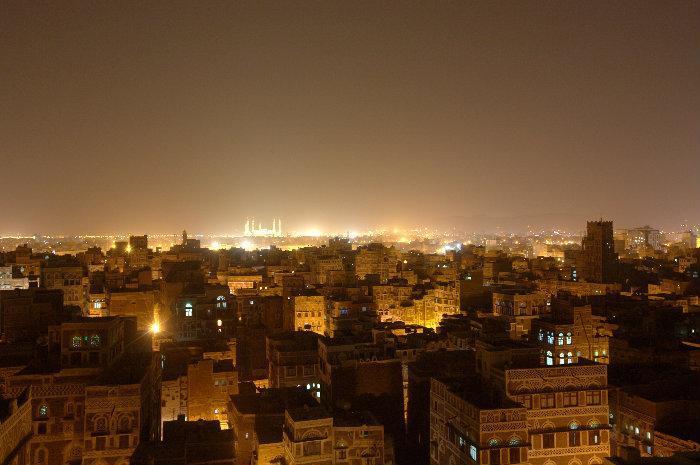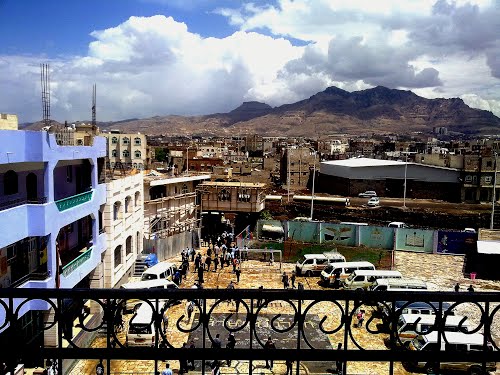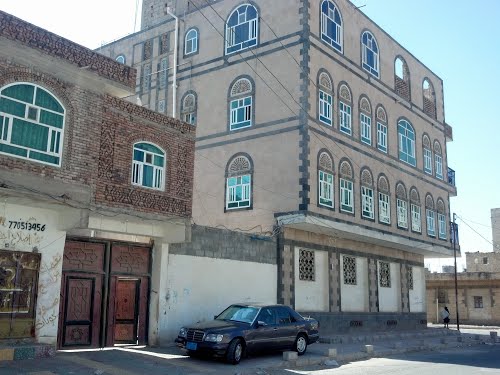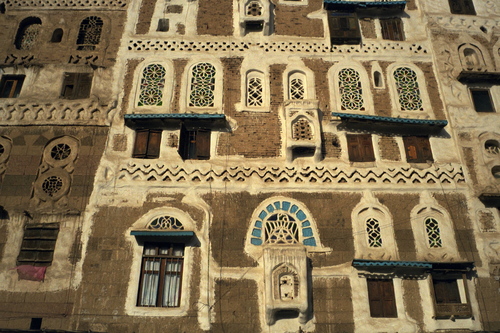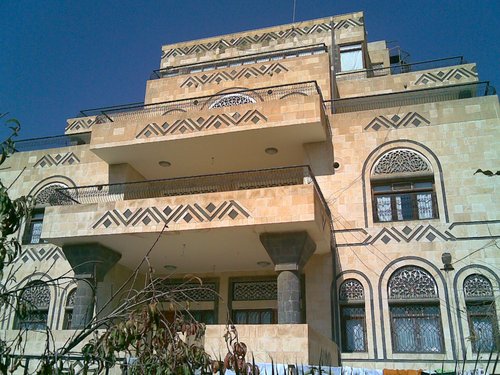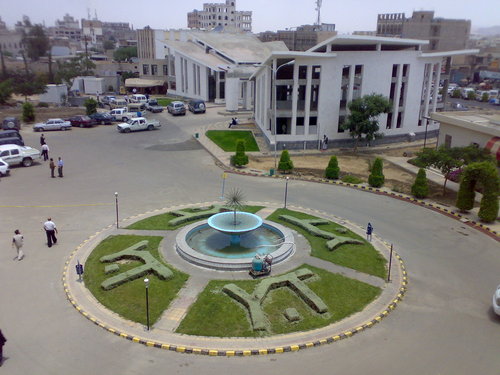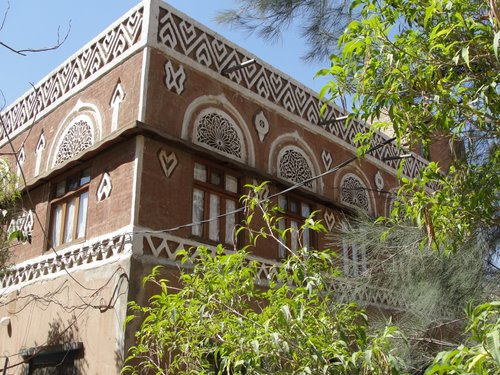Sanaa is the largest city in Yemen and the centre of Sanaa Governorate. The city is not part of the Governorate, but forms the separate administrative district of "Amanat Al-Asemah". Under the Yemeni constitution, Sanaa is the capital of the country, although the seat of the internationally recognised government moved to Aden in the aftermath of the 2014–15 Yemeni coup d'état. Aden was declared as the temporary capital by President Abd Rabbuh Mansur Hadi in March 2015.
Sanaa is one of the oldest continuously inhabited cities in the world. At an elevation of 2,300 metres, it is also one of the highest capital cities in the world. Sanaa has a population of approximately 1,937,500 (2012), making it Yemen's largest city.
The old city of Sanaa, a UNESCO World Heritage Site, has a distinctive visual character due to its unique architectural characteristics, most notably expressed in its multi-storey buildings decorated with geometric patterns. In the conflict that raged in 2015, bombs hit UNESCO sites. Located here is the Great Mosque of Sanaa, the largest in the city.
History
Ancient period
Sanaa is one of the oldest populated places in the world. According to popular legend, it was founded by Shem, the son of Noah. It was known as "Azal" in ancient times, which has been connected to Uzal, a son of Qahtan, a great-grandson of Shem, in the biblical accounts of Genesis. Its current name likely derived from the South Arabian word for "well-fortified", a name that echoes the meaning of the Ethiopian name - recorded in a Syriac account as Auzalites - the city held in the 6th century.
The Arab historian al-Hamdani wrote that Sanaa was walled by the Sabeans under their ruler Sha'r Awtar, who also arguably built the Ghumdan Palace in the city. Because of its location, Sanaa has served as an urban center for the surrounding tribes of the region and as a nucleus of regional trade in southern Arabia. It was positioned at the crossroad of two major ancient trade routes linking Marib in the east to the Red Sea in the west.
When King Yousef Athar, the last of the Himyarite kings, was in power, Sanaa was also the capital of the Ethiopian viceroys.
Islamic era
From the dawn of Islam until the founding of independent sub-states in many parts of the Yemen Islamic Caliphate, Sanaa persisted as the governing seat. The Caliph's deputy ran the affairs of one of Yemen's three Makhalifs: Mikhlaf Sanaa, Mikhlaf al-Janad and Mikhlaf Hadhramawt. The city of Sana'a regularly regained an important status and all Yemenite States competed to control it.
In 1062 Sanaa was taken over by the Sulayhid dynasty led by Ali al-Sulayhi and his wife, the popular Queen Asma. He made the city capital of his relatively small kingdom, which also included the Haraz Mountains. The Sulayhids were aligned with the Ismaili Muslim-leaning Fatimid Caliphate of Egypt, rather than the Baghdad-based Abbasid Caliphate which most of Arabia followed. Al-Sulayhi ruled for about 20 years but he was assassinated by his principal local rivals, the Zabid-based Najahids. Following his death, al-Sulayhi's daughter, Arwa al-Sulayhi, inherited the throne. She withdrew from Sanaa, transferring the Sulayhid capital to Jibla, where she ruled much of Yemen from 1067 to 1138. As a result of the Sulayhid departure, the Hamdanid dynasty took control of Sanaa.
In 1173 Saladin, the Ayyubid sultan of Egypt, sent his brother Turan-Shah on an expedition to conquer Yemen. The Ayyubids gained control of Sanaa in 1175 and united the various Yemeni tribal states, except for the northern mountains controlled by the Zaydi imams, into one entity. The Ayyubids switched the country's official religious allegiance to the Sunni Muslim Abbasids. During the reign of the Ayyubid emir Tughtekin ibn Ayyub, the city underwent significant improvements. These included the incorporation of the garden lands on the western bank of the Sa'ilah, known as Bustan al-Sultan, where the Ayyubids built one of their palaces. Despite Sanaa's strategic position, the Ayyubids chose Ta'izz as their capital while Aden was their principal income-producing city.
While the Rasulids controlled most of Yemen, followed by their successors the Tahirids, Sanaa largely remained in the political orbit of the Zaydi imams from 1323 to 1454 and outside the former two dynasties' rule. The Mamelukes arrived in Yemen in 1517.
Ottoman era
The Ottoman Empire entered Yemen in 1538 when Suleiman the Magnificent was Sultan. Under the military leadership of Ozdemir Pasha, the Ottomans conquered Sanaa in 1547. With Ottoman approval, European captains based in the Yemeni port towns of Aden and Mocha frequented Sanaa to maintain special privileges and capitulations for their trade. In 1602 the local Zaydi imams led by Imam al-Mu'ayyad reasserted their control over the area, and forced out Ottoman troops in 1629. Although the Ottomans fled during al-Mu'ayyad's reign, his predecessor al-Mansur al-Qasim had vastly weakened the Ottoman army in Sanaa and Yemen. Consequently, European traders were stripped of their previous privileges.
The Zaydi imams maintained their rule over Sanaa until the mid 19th-century, when the Ottomans relaunched their campaign to control the region. In 1835, Ottoman troops arrived on the Yemeni coast under the guise of Muhammad Ali of Egypt's troops. They did not capture Sana'a until 1872, when their troops led by Ahmed Muhtar Pasha entered the city. The Ottoman Empire instituted the Tanzimat reforms throughout the lands they governed.
In Sanaa, city planning was initiated for the first time, new roads were built, and schools and hospitals were established. The reforms were rushed by the Ottomans in order to solidify their control of Sanaa to compete with an expanding Egypt, British influence in Aden and imperial Italian and French influence along the coast of Somalia, particularly in the towns of Djibouti and Berbera. The modernization reforms in Sanaa were still very limited, however.
North Yemen period
In 1904, as Ottoman influence was waning in Yemen, Imam Yahya of the Zaydi imams took power in Sanaa. In a bid to secure North Yemen's independence, Yahya embarked on a policy of isolationism, avoiding international and Arab world politics, cracking down on embryonic liberal movements, not contributing to the development of infrastructure in Sanaa and elsewhere and closing down the Ottoman girls' school. As a consequence of Yahya's measures, Sanaa increasingly became a center of anti-government organization and intellectual revolt.
In the 1930s, several organizations opposing or demanding reform of the Zaydi imamate sprung up in the city, particularly Fatat al-Fulayhi, a group of various Yemeni Muslim scholars based in Sanaa's Fulayhi Madrasa, and Hait al-Nidal. By 1936 the leaders of these movements mostly imprisoned. In 1941 another group based in the city, the Shabab al-Amr bil-Maruf wal-Nahian al-Munkar, called for a nahda in the country as well as the establishment of a parliament with Islam being the instrument of Yemeni revival. Yahya largely repressed the Shabab and most of its leaders were executed following his son, Imam Ahmad's inheritance of power in 1948. That year, Sanaa was replaced with Ta'izz as capital following Ahmad's new residence there. Most government offices followed suit. A few years later, most of the city's Jewish population emigrated to Israel.
Ahmad began a process of gradual economic and political liberalization, but by 1961 Sanaa was witnessing major demonstrations and riots demanding quicker reform and change. Pro-republican officers in the North Yemeni military sympathetic of Gamal Abdel Nasser of Egypt's government and pan-Arabist policies staged a coup overthrowing the Imamate government in September 1962, a week after Ahmad's death. Sanaa's role as capital was restored afterward. Neighboring Saudi Arabia opposed this development and actively supported North Yemen's rural tribes, pitting large parts of the country against the urban and largely pro-republican inhabitants of Sanaa. The North Yemen Civil War resulted in the destruction of some parts of the city's ancient heritage and continued until 1968 when a deal between the republicans and the royalists was reached, establishing a presidential system. Instability in Sanaa continued due to continuing coups and political assassinations until the situation in the country stabilized in the late 1970s.
Contemporary era
Following the unification of Yemen, Sanaa was designated capital of the new Republic of Yemen. It houses the presidential palace, the parliament, the supreme court and the country's government ministries. The largest source of employment is provided by the governmental civil service. Due to massive rural immigration, Sanaa has grown far outside its Old City, but this has placed a huge strain on the city's underdeveloped infrastructure and municipal services, particularly water.
Sanaa was chosen as the 2004 Arab Cultural Capital by the Arab League. In 2008, the Saleh Mosque was completed. It holds over 40,000 worshipers.
On 21 May 2012, Sanaa was attacked by a suicide bomber, resulting in the deaths of 120 soldiers.
Recently, during the Houthi insurgency, the Houthis have seized, and currently control, Sanaa.
On 12 June 2015, Saudi-led airstrikes targeting Shiite rebels and their allies in Yemen destroyed historic houses in the center of the capital. A UNESCO World Heritage site is severely damaged.

